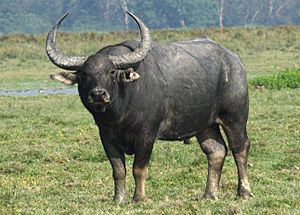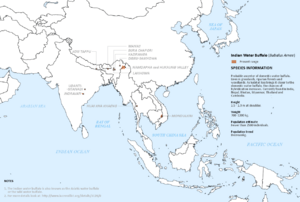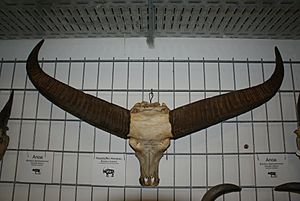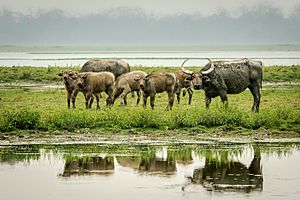Wild water buffalo facts for kids
Quick facts for kids Wild water buffalo |
|
|---|---|
 |
|
| in Kaziranga National Park | |
| Conservation status | |
| Scientific classification | |
| Genus: |
Bubalus
|
| Species: |
arnee
|
| Subspecies | |
|
|
 |
|
| Wild water buffalo range | |
The wild water buffalo (Bubalus arnee), also known as the Asian buffalo, is a very large animal related to cattle. It lives in the wild in parts of India and Southeast Asia. This amazing animal has been listed as an endangered species since 1986. This means its population is very low and it's at risk of disappearing.
There are fewer than 4,000 wild water buffalo left in the world. Their numbers have dropped by more than half in the last 24 to 30 years. Most of them, about 3,100, live in India, especially in a region called Assam. Scientists believe the wild water buffalo is the ancestor of the domestic water buffalo we see on farms today.
Contents
What is a Wild Water Buffalo?
The wild water buffalo has skin that can be ash-gray or black. Its hair is not very long, it's coarse, and it's thin. The hair grows forward from its back towards its head. It has a small tuft of hair on its forehead and small ears.
These buffalo are huge! They can be about 2.4 to 3 meters (8 to 10 feet) long from head to body. Their tail adds another 60 to 100 centimeters (2 to 3 feet). At the shoulder, they stand about 1.5 to 1.9 meters (5 to 6 feet) tall.
Both male and female wild water buffalo have impressive horns. These horns are thick at the base and spread out wide. They can reach up to 2 meters (6.5 feet) along their outer edges. This makes their horns bigger than any other living animal in the cattle family. The tip of their tail is bushy, and their hooves are large and spread out.
Wild water buffalo are bigger and heavier than domestic water buffalo. They can weigh from 600 to 1,200 kilograms (1,300 to 2,600 pounds). They are among the heaviest wild animals in the cattle family, just a bit smaller than the gaur.
Where Do They Live?
Wild water buffalo are found in India, Nepal, Bhutan, Thailand, and Cambodia. There might also be a small group in Myanmar. Sadly, they have disappeared from Bangladesh, Laos, Vietnam, and Sri Lanka.
These buffalo love wet places. They live in wet grasslands, swamps, areas that flood, and river valleys with lots of plants.
In India, you can mostly find them in and around national parks like Kaziranga and Manas in Assam. Small groups also live in other scattered areas. In the early 1990s, there were about 3,300 to 3,500 wild water buffalo in northeast India. By 1997, this number had dropped to less than 1,500 adult animals.
Many wild buffalo populations have mixed with domestic or wild water buffalo that have escaped from farms. This mixing can make it harder for the true wild species to survive.
Nepal's only wild water buffalo population lives in Koshi Tappu Wildlife Reserve. This group has grown from 63 animals in 1976 to 433 in 2016. Some of these buffalo were moved to Chitwan National Park in 2016 to start a new group.
Small numbers of wild water buffalo also live in Bhutan's Royal Manas National Park. In Thailand, small herds of fewer than 40 buffalo have been seen. In Cambodia, only a few dozen remain in the eastern provinces.
The wild buffalo in Sri Lanka are believed to be descendants of domestic water buffalo that were brought there long ago. It's unlikely that any truly wild water buffalo still exist there today.
Wild buffalo populations found in other parts of Asia, Australia, Argentina, and Bolivia are actually domestic water buffalo that have become wild.
Daily Life and Behavior
Wild water buffalo are active both during the day and at night. Adult females and their young live together in stable groups called clans. These clans can have up to 30 buffalo. They have a home area where they rest, eat grass, roll in mud (wallow), and drink water. Older female buffalo lead these clans.
Several clans can join together to form a larger herd of 30 to 500 animals. Adult males often form their own groups of up to 10. Older males sometimes live alone. During the dry season, males stay separate from the female clans.
Wild water buffalo usually have their young in October and November, but some groups breed all year. The males that are strongest mate with the females. After mating, the females usually chase the males away.
A female buffalo is pregnant for 10 to 11 months. They usually give birth to one calf, but sometimes they can have twins. Males can start having offspring at 18 months old, and females at three years old. In the wild, they can live up to 25 years.
What Do They Eat?
Wild water buffalo mostly eat grass. They also eat other plants, fruits, and tree bark. They sometimes eat crops like rice, sugarcane, and jute, which can cause problems for farmers.
Threats to Wild Water Buffalo
The biggest dangers to wild water buffalo are:
- Mixing with other buffalo: They often breed with domestic water buffalo or buffalo that have escaped from farms. This can make the wild species less pure.
- Hunting: People still hunt them, especially in Thailand, Cambodia, and Myanmar.
- Loss of habitat: Their homes, like floodplains, are being turned into farms or used for building dams.
- Invading plants: Some plants, like stem twiners, grow too much and harm the wetlands where buffalo live.
- Diseases: They can catch diseases and parasites from farm animals.
- Competition for food: They have to compete with farm animals for food and water.
These threats mean that the wild water buffalo population is likely to keep shrinking.
Protecting Wild Water Buffalo
The wild water buffalo is listed under CITES Appendix III. This means that trade in these animals is controlled to protect them. They are also legally protected in Bhutan, India, Nepal, and Thailand.
In 2017, 15 wild water buffalo were moved to Chitwan National Park in Nepal. This was done to create a second healthy group of buffalo in the country, helping to ensure their survival.
See also
 In Spanish: Búfalo de agua salvaje para niños
In Spanish: Búfalo de agua salvaje para niños




